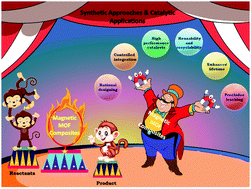Magnetic metal–organic framework composites: structurally advanced catalytic materials for organic transformations
Abstract
Over the past two decades, metal–organic framework (MOF) research has been a rising star in modern materials chemistry and engineering that has contributed immensely to advancing the frontiers of science. Amalgamation of MOFs with magnetic nanostructures represents a newer promising trend that allows researchers to design complex hybrid catalytic materials with enhanced separability, reusability and activity for desired organic reactions in comparison to the individual counterparts. There are a series of meritorious examples in the literature wherein magnetic MOF composites have been successfully employed as versatile catalytic systems. Thus, the present review article aims to present a compendious account of all those magnetic MOF composite-based catalytic materials reported to boost several organic transformations, including oxidation, hydrogenation, coupling, condensation, esterification and multicomponent reactions. A progressive trend of increasing applications of these magnetic MOF composites in the area of photocatalysis and biocatalysis has also been incorporated. Further, the synthetic routes employed to date for the fabrication of magnetic MOF composites depending upon mutual interactions that exist between the magnetic nanoparticles and the MOF during unification have been illustrated in detail. It is further anticipated that this review will not only enlighten the readers about magnetic MOF composites but also assist researchers in designing novel functionalized catalysts for sustainable development.



 Please wait while we load your content...
Please wait while we load your content...